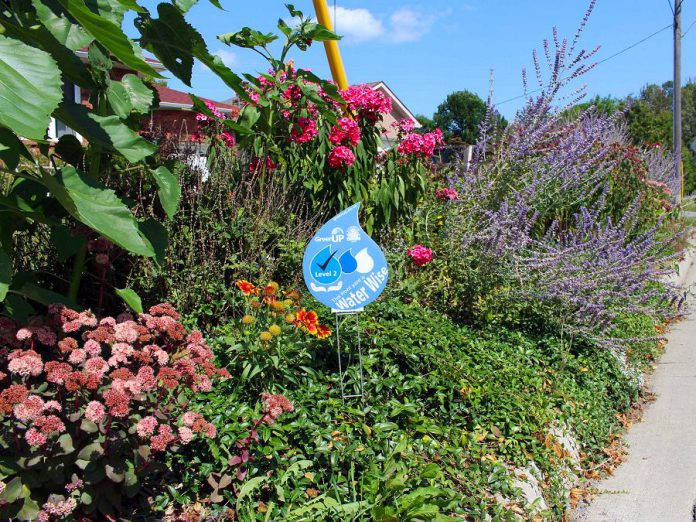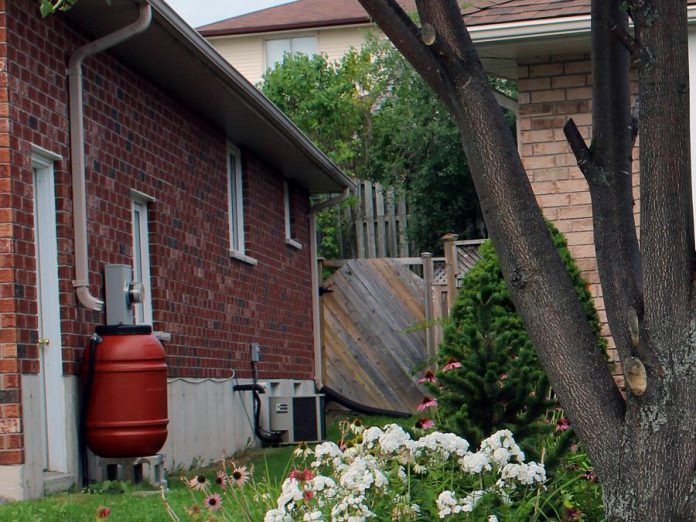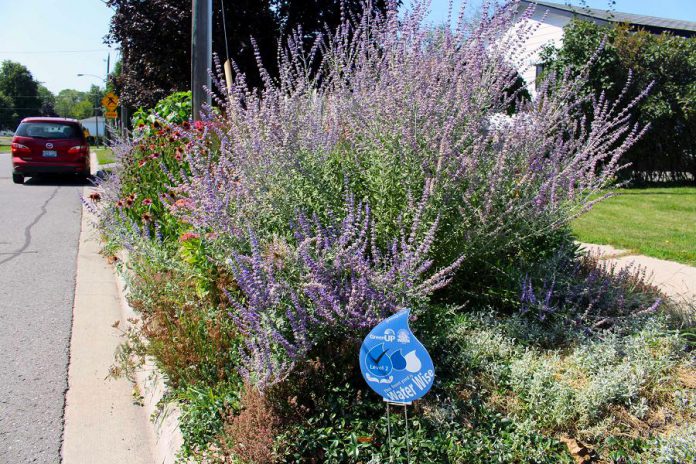
During the summer months, demands for water from activities such as watering lawns and gardens can significantly increase outdoor water consumption. Residential water use has been known to increase as much as 50 percent in the summer months, with outdoor water use largely responsible for this seasonal increase.
You can make the most positive impact during summer months by adopting Water Wise landscaping practices, which not only results in less water use but also ensures that every drop is used to its full potential.
The GreenUP Water Wise program aims to recognize the steps that some City of Peterborough residents are taking to curb outdoor water use. In addition, the program aims to inspire others to take Water Wise steps in their own yards.
One of the first Water Wise steps you can take is to capture rain in a rain barrel. The Peterborough Utilities Group offers a $25 subsidy for customers who purchase a rain barrel from the GreenUP Store.

The best way to use a rain barrel to its full potential is to use up your captured rain and keep the barrel empty, so it is ready to capture as much rain as possible from the next rain event. The rule of thumb is to drain before the next rain. For larger gardens with greater water requirements, you can also link multiple rain barrels together.
If you do need to turn on the tap to water your garden, remember to follow the summer watering restrictions advised by Peterborough Utilities Group. During June, July, and August, if your numerical street address is even, you may water only on even-numbered days between 7am and 10pm. If your street address is an odd number, you may water on odd-numbered days during the same time period.
Another Water Wise step is to avoid the use of sprinklers. Sprinklers often waste water, only providing a sprinkling to the leaves and top layers of soil or, on really hot days, may cause water to evaporate before it even reaches the plants. There are more efficient techniques for watering that allow you to give a drink of water straight to the root of the plant. For example, drip hoses are a great alternative to sprinklers, providing water directly into the soil.

Giving plants, especially drought-tolerant native species, an opportunity for a deep drink of water less often, as opposed to light amounts of water more frequently, will help encourage the roots to grow deeper — and thus will encourage the plant to become even more drought-tolerant.
If you do not currently have drought-tolerant plant species incorporated into your garden, another Water Wise step is to convert your lawn or existing garden into a Water Wise garden.
Water Wise neighbour Bernice Pepe did just this.
“My mother and father always stressed ‘not to waste’ in our household,” Pepe says. “In keeping with that philosophy of not wasting, soon after I moved to my current home in 2001, I began digging out one square yard of grass at a time from my front yard, replacing it with a drought resistant plants and shrubs.”

If converting your front yard from grass to garden all at once sounds like a daunting task, you could try what Pepe did. Start with a small section and work towards more Water Wise gardens, one small space at a time.
“It took me many years to create the current front yard, which is mostly gardens now,” she says.
GreenUP has created a Water Wise Garden Starter Kit to help you start the transition towards a Water Wise garden.
The kit is available at GreenUP Ecology Park Garden Market and comes with everything you need to plant a 35-square-foot Water Wise garden, including 17 plants of seven different species and a ready-to-plant garden design.
While all newly planted gardens require ample water in their first season, taking this Water Wise step this summer will help ensure a Water Wise summer for 2019 and beyond.
“Since the creation of my drought resistant front yard, I have not had to water in over ten years,” Pepe explains. “The garden gets only what falls from the heavens.”
To conserve moisture and control soil temperature, you can also apply two to three inches of mulch over the surface of your garden. Mulch will also help to supress weed growth that would otherwise compete with your plants for water.
If you prefer to maintain some lawn space, there are also Water Wise steps you can take to minimize water use on grass. To help retain moisture, you can mow your lawn less often and maintain a minimum height of three inches, while leaving clippings on the lawn.
For a greener lawn next summer, remove any build-up of thatch, consider over-seeding with grass seed, or mix your grass seed with clover.
If everyone adopts at least one Water Wise step this summer, we can help to ensure that enough water remains for everyone and everything, including your garden.
To find out more about Water Wise, nominate a garden for recognition, or be inspired by the Water Wise steps of your neighbours, visit greenup.on.ca/water-wise/ or contact Heather Ray at heather.ray@greenup.on.ca or 705-745-3238 ext. 204.
For more information about summer water restrictions, visit peterboroughutilities.ca.


























